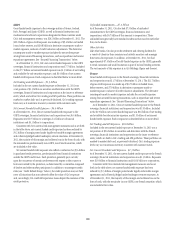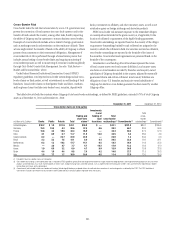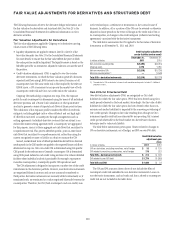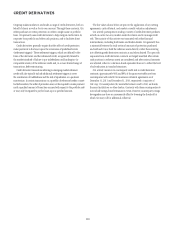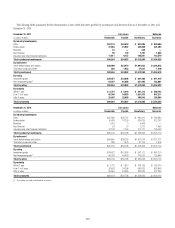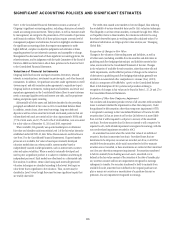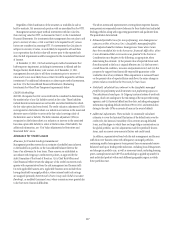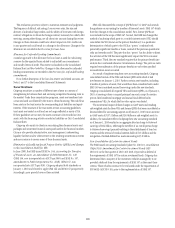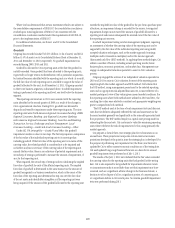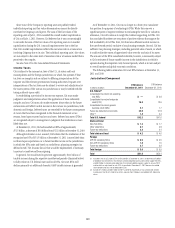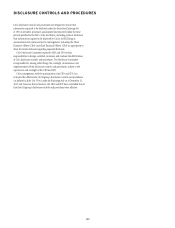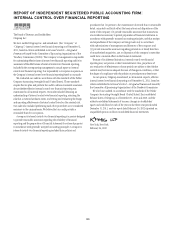Citibank 2011 Annual Report Download - page 140
Download and view the complete annual report
Please find page 140 of the 2011 Citibank annual report below. You can navigate through the pages in the report by either clicking on the pages listed below, or by using the keyword search tool below to find specific information within the annual report.118
This evaluation process is subject to numerous estimates and judgments.
The frequency of default, risk ratings, loss recovery rates, the size and
diversity of individual large credits, and the ability of borrowers with foreign
currency obligations to obtain the foreign currency necessary for orderly debt
servicing, among other things, are all taken into account during this review.
Changes in these estimates could have a direct impact on Citi’s credit costs
in any quarter and could result in a change in the allowance. Changes to the
allowance are recorded in the Provision for loan losses.
Allowance for Unfunded Lending Commitments
A similar approach to the allowance for loan losses is used for calculating
a reserve for the expected losses related to unfunded loan commitments
and standby letters of credit. This reserve is classified on the Consolidated
Balance Sheet in Other liabilities. Changes to the allowance for unfunded
lending commitments are recorded in the Provision for unfunded lending
commitments.
For a further description of the loan loss reserve and related accounts, see
Notes 1 and 17 to the Consolidated Financial Statements.
Securitizations
Citigroup securitizes a number of different asset classes as a means of
strengthening its balance sheet and accessing competitive financing rates in
the market. Under these securitization programs, assets are transferred into
a trust and used as collateral by the trust to obtain financing. The cash flows
from assets in the trust service the corresponding trust liabilities and equity
interests. If the structure of the trust meets certain accounting guidelines,
trust assets are treated as sold and are no longer reflected as assets of Citi.
If these guidelines are not met, the assets continue to be recorded as Citi’s
assets, with the financing activity recorded as liabilities on Citi’s Consolidated
Balance Sheet.
Citigroup also assists its clients in securitizing their financial assets and
packages and securitizes financial assets purchased in the financial markets.
Citi may also provide administrative, asset management, underwriting,
liquidity facilities and/or other services to the resulting securitization entities
and may continue to service some of these financial assets.
Elimination of Qualifying Special Purpose Entities (QSPEs) and Changes
in the Consolidation Model for VIEs
In June 2009, the FASB issued SFAS No. 166, Accounting for Transfers
of Financial Assets, an amendment of FASB Statement No. 140
(SFAS 166, now incorporated into ASC Topic 860) and SFAS No. 167,
Amendments to FASB Interpretation No. 46(R) (SFAS 167, now
incorporated into ASC Topic 810). Citigroup adopted both standards on
January 1, 2010 and elected to apply SFAS 166 and SFAS 167 prospectively.
Accordingly, prior periods have not been restated.
SFAS 166 eliminated the concept of QSPEs from U.S. GAAP and amends
the guidance on accounting for transfers of financial assets. SFAS 167 details
three key changes to the consolidation model. First, former QSPEs are
now included in the scope of SFAS 167. Second, the FASB has changed the
method of analyzing which party to a variable interest entity (VIE) should
consolidate the VIE (known as the primary beneficiary) to a qualitative
determination of which party to the VIE has “power,” combined with
potentially significant benefits or losses, instead of the previous quantitative
risks and rewards model. The party that has “power” has the ability to direct
the activities of the VIE that most significantly impact the VIE’s economic
performance. Third, the new standard requires that the primary beneficiary
analysis be re-evaluated whenever circumstances change. The previous rules
required reconsideration of the primary beneficiary only when specified
reconsideration events occurred.
As a result of implementing these new accounting standards, Citigroup
consolidated certain of the VIEs and former QSPEs with which it had
involvement on January 1, 2010. Further, certain asset transfers, including
transfers of portions of assets, that would have been considered sales under
SFAS 140 are considered secured borrowings under the new standards.
Citigroup consolidated all required VIEs and former QSPEs, as of January 1,
2010, at carrying values or unpaid principal amounts, except for certain
private-label residential mortgage and mutual fund deferred sales
commissions VIEs, for which the fair value option was elected.
The incremental impact of these changes on GAAP assets and resulting
risk-weighted assets for those VIEs and former QSPEs that were consolidated or
deconsolidated for accounting purposes as of January 1, 2010 was an increase
in GAAP assets of $137.3 billion and $24.0 billion in risk-weighted assets. In
addition, the cumulative effect of adopting these new accounting standards
as of January 1, 2010 resulted in an aggregate after-tax charge to Retained
earnings of $8.4 billion, reflecting the net effect of an overall pretax charge
to Retained earnings (primarily relating to the establishment of loan loss
reserves and the reversal of residual interests held) of $13.4 billion and the
recognition of related deferred tax assets amounting to $5.0 billion.
Non-Consolidation of Certain Investment Funds
The FASB issued Accounting Standards Update No. 2010-10, Consolidation
(Topic 810), Amendments for Certain Investment Funds (ASU
2010-10) in the first quarter of 2010. ASU 2010-10 provides a deferral of
the requirements of SFAS 167 for certain investment funds. Citigroup has
determined that a majority of the investment vehicles managed by it are
provided a deferral from the requirements of SFAS 167 as they meet these
criteria. These vehicles continue to be evaluated under the requirements of
FIN 46(R) (ASC 810-10), prior to the implementation of SFAS 167.


